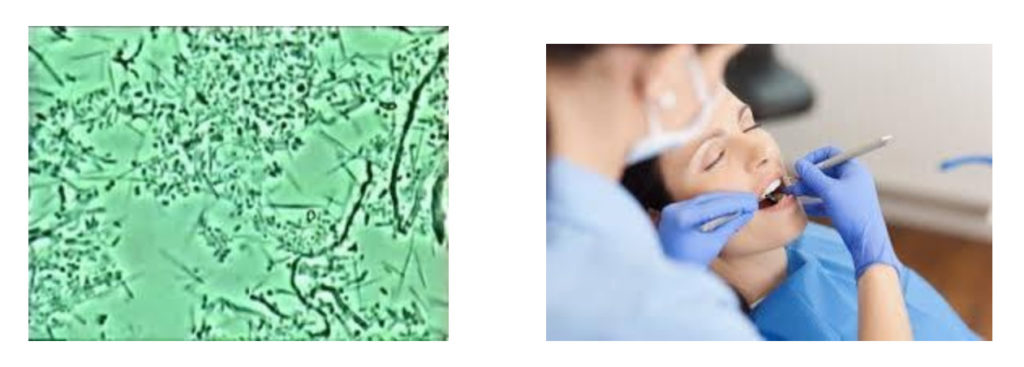Lyme Disease and the Dental Connection

What you need to know
Lyme disease (Lyme borreliosis) is caused by the tick-borne spirochete bacterium Borrelia burgdorfer.
Lyme disease is a multisystem inflammatory disease and neurologic, articular, and cardiac manifestations may follow untreated early infection. While the B. burgdorferi bacterium does not make toxins or cause direct tissue damage, local inflammation results from host response mechanisms.
It is a commensal organism which means it can perfectly exist in a host without causing any symptoms. However, when the host immunity / Autonomic immune system is compromised it puts the host at risk for active lyme infection.
Three phases of general clinical manifestations
- Early localized: distinct, bull’s eye or target skin lesions in warm areas of the body (groin, axilla or belt line) that may itch, burn or hurt.
- Early disseminated: if treatment is not initiated involvement of brain or heart may occur.
- Late disease: also called as Post Treatment Lyme Disease Syndrome (PTLDS), this phase leads to muscle and bone involvement.

(spirochetes under electron microscope from a dental plaque sample). They appear corkscrew shaped. If left long enough they form colonies and you can watch them attack immune cells like neutrophils, leukocytes.
The link between Lyme disease and dental health
Most spirochetes are free-living and anaerobic. They are cork screw shaped. They flourish in an environment that supports this condition.
Acidosis (an acidic condition of the body) which reduces available oxygen to the cells can contribute to the increased presence of this bacteria. Every time the oral pH is less than 6.5 it is usually correlates to seeing spirochetes in the gums. We encourage our clients to work on their pH and keep an alkaline mouth. We provide tips on how to be alkaline.
Root canal treated teeth (where the blood supply is cut off) harbors spirochetes in record numbers in their dentinal tubules. Spirochetes are usually seen with chronic periodontitis which also presents with systemic inflammation symptoms.
A simple plaque sample under phase contrast microscope or a histopathological slide of a root canal treated tooth can reveal spirochetes. Root canal treated teeth can be sent to DNA connexions lab for testing to see what pathogens reside in them and usually spirochetes are one among them.
It has been observed that Lyme and many other chronic diseases are fed by spirochetes that develop in root canals where teeth have been extracted. Lyme bacteria exists in the teeth, not in the enamel. The spirochete bacterium love to occupy in the dentin and some up to three miles of tiny tubules.
Manifestations
Clinical manifestations may include facial and dental pain (tooth ache), facial nerve palsy, headache, temporomandibular (jaw) joint pain, and masticatory (chewing) muscle pain. The effects that can precipitate when performing dental procedures on a patient with Lyme disease must also be considered1
Symptoms of oral presentations
Symptoms associated with Lyme disease include headache and facial pain that often mimics dental pathology and temporomandibular (such as TMJ) disorders.
Other oral symptoms can be:
- Dry mouth
- Tooth sensitivity
- Pulpitis, or the oral inflammation of dental pulp
- Bell’s palsy, or partial facial paralysis
- Cranial nerve palsy may occur in early disseminated disease. Bell’s palsy is a form of usually temporary facial neuropathy resulting from inflammation/damage to the seventh cranial nerve (i.e., facial nerve)
- Involvement of the saliva producing glands may manifest as brief inflammation of the gland.
- Bad Breath in spite of impeccable hygiene.
- Acidic oral pH.
“Sometimes the dental patient may present nonspecific orofacial pain and headaches that can mimic temporomandibular joint pain”. “Dentists should consider Lyme disease as a possible cause if a patient presents these or related symptoms and has no specific oral health problem. These patients should be referred to a physician.”5
What do we do about it?
- If a patient is worried about contracting Lyme disease, he/she should visit a medical care provider and dental hygienist to check the mouth for indications of Lyme. At Prime Integrative Dentistry we utilize phase contrast microscope to visualize pathogens residing in your dental plaque, and repeat the plaque slide test after treatment to ensure everything is sterilized.
- Oil pulling will help balance the oral microflora.
- Successive high concentration ozone gas treatments will kill spirochetes giving you a clean mouth and healthy gums.
Contact Dr. Mirkal and schedule a consultation for any questions. Prime Integrative Dentistry is a Green and Holistic/Biological Dentistry providing a health focused approach.
References
- Lyme disease: considerations for dentistry. J Orofac Pain. 1996 Winter;10(1):74-86.
- Lyme disease awareness for the New Jersey dentist. A survey of orofacial and headache complaints associated with Lyme disease. J N J Dent Assoc. 1998 Winter;69(1):19, 21, 62-3 passim.
- Lyme disease: College of Dental Hygienists of Ontario.
- References Lyme disease: considerations for dentistry. J Orofac Pain. 1996 Winter;10(1):74-86. Lyme disease awareness for the New Jersey dentist. A survey of orofacial and headache complaints associated with Lyme disease. J N J Dent Assoc. 1998 Winter;69(1):19, 21, 62-3 passim. Lyme disease: College of Dental Hygienists of Ontario.
- https://www.ada.org/en/publications/ada-news/2017-archive/june/dentists-can-help-fight-against-tickborne-diseases

